#kachol lavan
Text
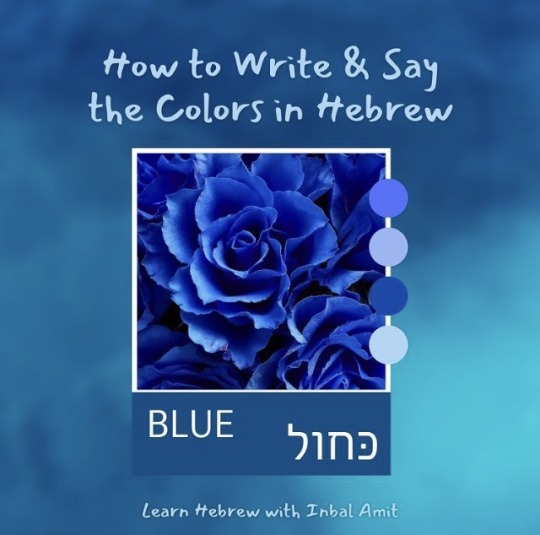




After you learned how to write and say the color White yesterday, I wanted to teach you the color Blue, as these two colors comprise of the Israeli flag. What better two colors to start with?
Once you learn how to say and write it, and practiced writing it in Print and Cursive in your Workbook / Notebook, you can search and listen to the oldie and classic love song to the Israeli flag and how Blue and White is my color by Zmira Chen. Search for Kachol Ve'lavan, which means Blue and White, and you will hear the words Kakhol and Lavan with a Ve for And in the middle - in this beautiful song.
Feel free to share your practice to get my feedback on your writing / pronunciation.
See you tomorrow with another color. Follow for more Jewish and Hebrew content!
#hebrew#jewish#learnhebrew#israel#language#jew#torah#trending#viral#instagram#viral today now#amazon#did you know#marriage#my husband#best sellers#love#shabbat#goalsetting#life goals#blue aesthetic#blue#my flags
0 notes
Text
Vocab from My First Hebrew Word Book
I found a PDF of Judyth Groner’s My First Hebrew Word Book, and even though it’s aimed at literal preschoolers, it’s been helpful for an amateur like me! The words in the book are written with nikud (the little vowel dots) since it’s aimed at kids, so I tried to find the ktiv malé/full spelling equivalents. Here’s the list of vocab (below the cut)--there’s nearly 175 words! As always, feel free to let me know if I made any mistakes, which is very possible!
I - אני ani
hair - שיער sei'ar
head - ראש rosh
eyes - עיניים einayim
mouth - פה peh
hands - ידיים yadayim
legs - רגליים raglayim
body - גוף guf
tummy - בטן beten
face - פנים panim
ears - אוזניים oznayim
nose - אף af
family - משפחה mishpachah
cat - חתול chatul
grandpa - סבא saba
grandma - סבתא savta
brother - אח ach
uncle - דוד dod
aunt - דודה dodah
baby - תינוק tinok
mother - אמא ima
father - אבא aba
sister - אחות achot
clothes - בגדים b'gadim
shoes - נעליים na'alayim
pants - מכנסיים michnasayim
sweater - סוודר s'veder
shirt - חולצה chultzah
hanger - קולב kolav
skirt - חצאית chatza'it
hat - כובע kova
jacket - ז'קט m'eel
mirror - ראי r'ee
socks - גרביים garbayim
house - בית bait
roof - גג gag
window - חלון chalon
door - דלת delet
fence - גדר gader
bird - ציפור tzipor
grass - דשא deshe
flowers - פרחים p'rachim
tree - עץ etz
mailbox - תיבת דואר tevat do'ar
steps (stairs) - מדרגות madregot
living room - חדר אורחים chadar orchim
television - טלוויזיה televizya
sofa - ספה sapah
rug - שטיח shatiach
computer - מחשב machshev
telephone - טלפון telefon
table - שולחן shulchan
kitchen - מטבח mitbach
knife - סכין sakin
fork - מזלג mzaleg
spoon - כפית capit
pot - סיר siyr
oven - תנור tanur
refrigerator - מקרר m'karer
school - בית ספר beit sefer
students - תלמידים talmidim
paper - עיתון n'yar
scissors - מספריים misparayim
chalk - גיר gir
bookbag/backpack - ילקוט yalkut
books - ספרים s'farim
chair - כיסא kisei
pencil - עיפרון iparon
desk - שולחן shulchan
crayons - עפרונות tz'va'im
chalkboard - לוח lu'ach
teacher - מורה morah
playground - מגרש משחקים migrash mis'chakim
kite - עפיפון afifon
ball - כדור kadur
slide - מגלישה magleshah
children - ילדים y'ladim
sandbox - ארגז חול argaz chol
bicycle - אופניים ofanayim
swing - נדנדה nadnedah
roller skates - גלגיליות galgiliyot
jump rope - חבל קפיצה chevel k'fitzah
bench - ספסל safsal
city - עיר ir
bus - אוטובוס otobus
street - רחוב r'chov
truck - משאית masa'it
car - מיכונית m'chonit
restaurant - מסעדה misadah
building - בניין binyan
traffic light - רמזור ramzor
airplane - מטוס matos
store - חנות chanut
library - ספרייה sifriyah
grocery store - מכולת makolet
tomato - עגבנייה agvaniyah
bread - לחם lechem
cookies - עוגיות oogiyot
milk - חלב chalav
potato - תפוח אדמה tapu'ach adamah
shopping cart - עגלה agalah
eggs - ביצים beitzim
chicken - עוף oaf
apple - תפוח tapu'ach
orange (food) - תפוז tapuz
bedtime - זמן שנה z'man shenah
bed - מיטה mitah
blanket - שמיכה s'michah
pillow - כרית katir
lamp - מנורה m'norah
book - ספר sefer
clock - שעון sha'on
closet - ארון aron
teddy bear - דובון dubon
moon - ירח yare'ach
stars - כוכבים kochavim
bathtime - זמן רחצח z'man rachtzah
soap - סבון sabón
boat - סירה sirá
bubbles - בועות bu'ot
bathtub - אמבטיה ambátya
water - מים máyim
towel - מגבת magévet
toothbrush - מברשת שיניים mivréshet shináyim
toilet - שירותים sherutím
sink - כיור kiyór
hairbrush - מברשת שיער mivreshet se'ar
birthday - יום הולדת yom-hulédet
balloons - בלונים balonim
friends - חברים khaverím
clown - ליצן leitzán
camera - מצלמה matzlemá
ice cream - גלידה glidá
candy - ממתק mamtak
present - מתנה mataná
candles - נרות nerót
cake - עוגה ugá
juice - מיץ mits
zoo - גן חיות gan khayót
bear - דוב dov
lion - אריה aryé
elephant - פיל píl
tiger - נמר namér
monkey - קוף kof
parrot - תוכי túki
snake - נחש nakhásh
giraffe - ג'ירפה jírafa
camel - גמל gamál
seal - כלב ים kélev-yam
spring - אביב avív
rainbow - קשת késhet
rain - גשם géshem
umbrella - מטריה mitriyá
summer - קיץ káyits
sun - שמש shémesh
beach - חוף khof
autumn - סתו s'táv
wind - רוח rúakh
leaves - עלים alím
winter - חורף khóref
sled - מזחלת mizhelet
snowman - איש שלג ísh shéleg
snow - שלג shéleg
colors - צבעים tz'va'im
red - אדום adom
green - ירוק yarok
black - שחור shachor
brown - חום chum
orange - כתום katom
white - לבן lavan
blue - כחול kachol
purple - סגול sagol
yellow - צהוב tzahov
56 notes
·
View notes
Text

Tomorrow (September 17) the Israeli elections will take place. This is the latest poll. The numbers may be a bit wonky given that voter turnout is expected to be particularly low due to this being the first back to back election in Israeli history and the myriad measures that Likud is putting in place to prevent Palestinian Israelis from voting. These numbers don't look good at all, I predict that there will either be a Netanyahu government or he will fail to make a coalition and there will be another round in another 5 months.
The 'liberal' / left parties standing this time around are Kachol Lavan, Joint List, Labor, and Democratic Union. Together if this projection is correct they'll have 53 seats of the necessary 61 to form a coalition.
The right consists of Likud, Shas, United Torah, United Right, Otzma Yehudit, and Yisrael Beitanu. According to this projection they should have 67, but there's a problem.
Yisrael Beitanu, the party of Avigdor Lieberman, is a very right wing and very secular party (this is a problem) currently embroiled in a feud with Netanyahu and Co. Lieberman therefore with his 9 seats will be the kingmaker in this election.
Kachol Lavan has been making googly eyes at Lieberman for a while now. They even have a vote sharing agreement in place to scoop up the votes of those parties who fail to pass the threshold. The trouble lies in the sheer unlikelihood of Kachol Lavan, a center right party that through the sheer insanity of Israeli politics gets to be The Left™ being able to form a successful government. On the one hand, Lieberman fits into this grouping as someone who wants to curb the powers of religious authorities, on the other hand he's a professional racist, opponent of a peaceful resolution with the PA as opposed to the other parties of this would-be coalition.
But he's also unwelcome in right wing pro-Netanyahu circles. He's responsible more than anyone else for the debacle that caused Israel's elections in April, as he had a scuffle with Netanyahu for being too soft on Hamas and ultimately left the Likud coalition. His secularism is a threat to United Torah and Shas, who almost exclusively represent religious Ashkenazis and Mizrahis respectively. Personal feuds between Netanyahu and Lieberman aside, his presence is anathema to these religious factions as now more than ever he has been pushing for mandatory drafting of Haredi Jews, who currently have exemptions. It's a collosal burden to keep all of them together in a coalition.
The Kachol Lavan-Lieberman alliance is even more fraught. Assuming that Gantz and Lapid can successfully create a coalition between Yisrael Beitanu and the other parties they would need, they'd still only have 62 seats, meaning that all it takes to bring down the government is two MKs deciding that they're unhappy with the government and going independent to leave the coalition. Meaning, it's over, another round of elections. And even if by some miracle this coalition holds together, with such a toxic mix the best that could happen is a haphazard maintenance of the status quo that leaves everybody unsatisfied and brings back a right wing government in the coming elections.
The one thing that can be said for certain is that tomorrow is going to be a real clusterfuck no matter what happens.
16 notes
·
View notes
Link
The Israeli government of Prime Minister Benjamin Netanyahu has in recent days launched a series of military strikes across the Middle East. The scope of the attacks itself represents a new escalation for Israel, bombing not just regional allies of Iran in Syria but also targets in Lebanon and deep inside Iraq. Notably, the attacks are simultaneous with new diplomatic momentum between the U.S. and Iran and talk of a potential meeting between Iranian President Hassan Rouhani and President Trump.
Israel rarely publicly accepts responsibility for its international military and intelligence operations. However, Netanyahu has been remarkably open about taking credit for the recent spate of strikes. “We will act—and currently are acting—against them [Iran], wherever it is necessary,” he recently declared. When asked if Iraq is also a target for attacks, Netanyahu responded: “I am not limiting myself.” Israel has also been widely blamed for the strikes in Lebanon but has not openly claimed them.
This acknowledgement of the strikes threatens dangerous escalation across the region. In the face of provocative admissions from Netanyahu and other Israeli officials, Iranian leaders and their regional allies will be hard-pressed to ignore the strikes and not respond. Importantly, it is a myth that groups like the Popular Mobilization Forces (PMF) in Iraq, Hezbollah in Lebanon, and the Houthis in Yemen are Iranian puppets. To the contrary, these groups all have their own constituencies and are entrenched in local politics. Their power reflects demographic realities and they have domestic goals. Consequently, for reasons not having anything to do with Iran, they will also face internal pressure to retaliate.
The Israeli strikes come on the heels of a significant diplomatic initiative by French President Emmanuel Macron to facilitate renewed U.S.-Iran negotiations. After meeting President Trump and Iranian Foreign Minister Javad Zarif during the G7 Summit in Biarritz, Macron declared “a roadmap has sort of been set…” He added that “in the next few weeks, based on our discussions, a meeting may take place between the two leaders,” which he surmised “is going to lead to bringing an end to escalation and reaching a suitable solution to this [standoff].”
The timing of the Israeli strikes suggests they are at least partly aimed at scuttling the potential for such a meeting. A primary goal of Netanyahu’s government has been the prevention of any agreement between the U.S. and Iran. This goal is apparent by the nature of Israel’s lobbying in Washington and its behavior with respect to U.S.-Iran relations. Netanyahu was one of the few world leaders who opposed the Obama administration’s negotiations with Iran and the July 2015 nuclear deal between Iran and global powers (the Joint Comprehensive Plan of Action, or JCPOA). To sabotage that diplomatic process, Netanyahu went as far as violating traditional diplomatic protocol by circumventing President Obama to address a joint session of Congress and criticize the negotiations in March 2015.
Trump's Leverage Over Netanyahu
For many on the Israeli right, the assumption has been that the price to be paid would come in the form of unwanted concessions to the Palestinians in the Trump peace initiative. Trump administration officials such as Jared Kushner and Jason Greenblatt have often said that there will be elements in their plan that will make both sides unhappy and that compromise will be required. Right-wing Israeli political leaders, such as Naftali Bennett, have for this reason stated in the past that they are grateful to Trump but do not want him proposing any type of peace plan, understanding that no matter how favorably tilted toward Israel, any peace initiative that conforms to a traditional framework will involve elements that the Israeli right will not want to swallow.
There have been multiple signals this week, however, that this view of the situation is incorrect. A variety of clues lead to the conclusion that the price of Trump’s unprecedented policy moves will not necessarily come as part of his peace initiative, but that the peace initiative itself will be another gift in service of his actual ask, which will be tacit Israeli acquiescence to the Trump administration entering into negotiations and an eventual nuclear deal of its own with Iran. Should this be the manner in which events unfold, it will place Netanyahu in the situation of having to decide whether he is willing to trade his political future for the policy goal that he has espoused for decades — containing Iran and denying its nuclear aspirations — or whether he is willing to cast aside the animating idea of his career in return for remaining in the prime minister’s office.
The past few days have featured some curious news items. After saying last week that any peace initiative to be unveiled would come following Israeli elections, Trump abruptly reversed course this week and told reporters that some elements of the plan may be released before the September 17 vote, which then prompted Greenblatt to clarify on Twitter that the plan would actually only come after the election. This came in conjunction with Netanyahu saying at a campaign event on Wednesday with an unusual degree of certainty that the Trump plan would be released after the election, and likely without much of a delay.
On top of this, a Likud internal poll was leaked that asked respondents whether Trump should release his plan before or after the election, or whether it would matter if Trump gave Israel the green light to annex the Jordan Valley or existing settlements before the election. All of this was then followed by Bennett, who as noted above has publicly expressed his opposition to any Trump plan being released, telling Israeli reporters that he will examine any Trump proposal seriously because of the president’s true friendship for Israel.
None of this seems like mere coincidence. It points to a White House that is planning on releasing a peace plan during coalition negotiations – which is the way to avoid charges of trying to influence the outcome of the election itself – and having in that peace plan components that will help Netanyahu form a government; namely, American cover for Israel to proceed with unilateral annexation. Should the election result in another deadlock and this scenario with a Trump peace initiative plays out, Netanyahu will point to the unprecedented concession that he has gotten from the U.S. – something far beyond the Bush-Sharon letter, which effectively conceded future Israeli sovereignty over settlement blocs but only in the context of a negotiated peace agreement – and argue that none of this would have happened absent his leadership and the relationship that he has cultivated with Trump. When portrayed as a historic opportunity to apply sovereignty to areas of the West Bank that may never again present itself, and which depends on Netanyahu in order to see it through, it will be difficult for Kachol Lavan to remain insistent that it will only join a unity government that does not include Netanyahu.
But none of this changes the fact that Trump will still have not asked Israel for anything in return, and this is where the Iran variable enters the equation. As Trump has made his desire to negotiate with the Iranian regime increasingly clear, Netanyahu and Israeli officials have made their concern over this outcome just as clear. While it is difficult to imagine Netanyahu publicly confronting Trump on anything, Netanyahu has made great political hay over the past four years of his willingness to stand up to President Obama over this precise issue, and forsaking the same principle when it comes to Trump will create a real credibility problem for the prime minister. A peace initiative that enables Netanyahu to remain prime minister by allowing him to take credit for American acquiescence to West Bank annexation or application of Israeli sovereignty over settlements is the most valuable chip that Trump is able to cash in if seeking to forestall a Netanyahu response to a future Iran policy that looks awfully similar to Obama’s.
15 notes
·
View notes
Text
Opinion // Donald Trump Wants to Revoke My Citizenship. Because I'm an Arab
Trump’s Mideast plan pushes the hard right dream of population transfer: the involuntary revocation of Israeli citizenship for 300,000 people. We, the Arab minority, had no say
— Dr. Anwar Mhajne | Haaretz | February 12, 2020
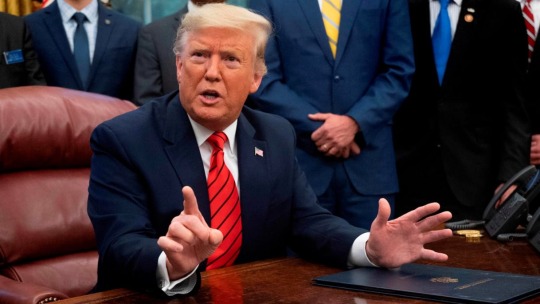
'The White House endorses revoking the citizenship of 300,000 inhabitants of Israel's Arab communities': US President Donald Trump in the Oval Office of the White House, Feb 11, 2020
President Donald Trump wants to revoke my citizenship. Because I am an Arab.
No, not in the United States, but in Israel. His Mideast "Deal of the Century" endorses an exchange: Multiple Arab towns in northern Israel would come under the writ of a future Palestinian state, and in exchange, Israel would annex Jewish settlements situated in the Palestinian territories.
This dry description doesn’t do the idea justice. This is what it really is: A population transfer conducted without any consultation with the people affected. A policy position based on ignorance about the complex layers of identity of Arab citizens of Israel, already targets of incitement and racism by Israel’s right-wing. And a legitimation of the hard right aspiration towards an homogenously Jewish Israel, where minorities are conditional guests and whose citizenship is not equal in origin or rights.
Those Arab towns are situated in what is known as the "Triangle," a region with an Arab majority bordering the northwest corner of the West Bank. For the Israeli establishment, that Arab population is a demographic threat to the Jewish nature of the Israeli state, together with general anxieties about the high birth rate among Arab families in Israel and Palestine.
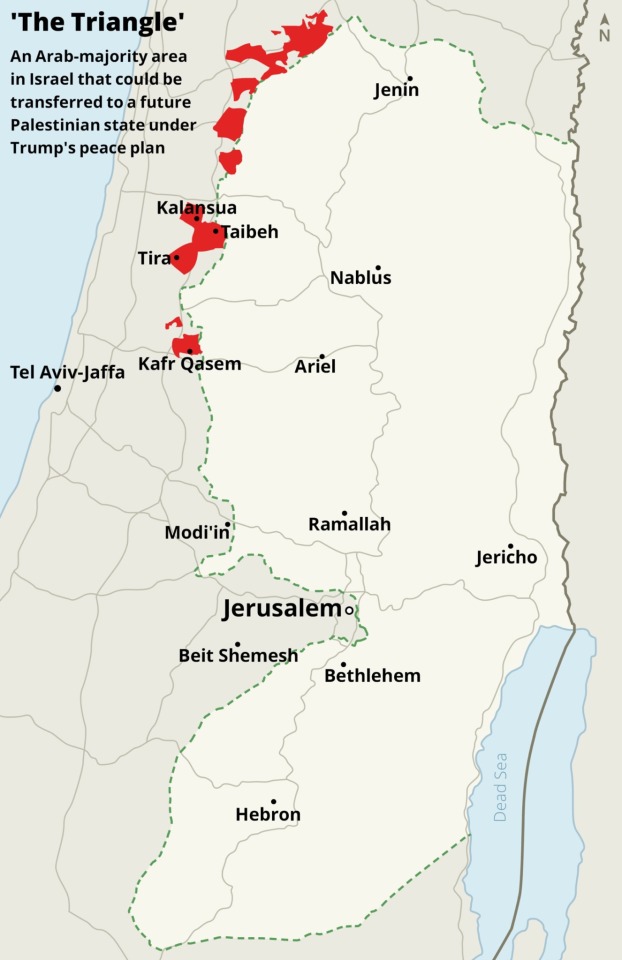
The Trump plan "contemplates the possibility, subject to agreement of the parties that the borders of Israel will be redrawn such that the Triangle Communities become part of the State of Palestine…the civil rights of the residents...would be subject to the applicable laws and judicial rulings of the relevant authorities."
The plan "explains" that, since the security concerns prompting Israel to acquire these Arab communities in 1949 have since been resolved, these communities could now be passed on to a future Palestinian state. "These communities, which largely self-identify as Palestinian, were originally designated to fall under Jordanian control during the negotiations of the Armistice Line of 1949, but ultimately were retained by Israel for military reasons that have since been mitigated."
The White House is giving a rationale for revoking the Israeli citizenship of the 300,000 inhabitants in these communities - myself included. Who would decide the fate of these communities? There is no mechanism mentioned to gauge grassroots Arab opinion. Would there be a localized referendum? Or would it be left to the Israeli and U.S. administrations to "benevolently" decide the fate and citizenship status of a quarter of a million citizens of Israel?
Removing our agency is only one aspect of Trump’s plan. Another is the superficial and ignorant foundations on which the "analysis" the Arab communities in Israel are based, not least, the blanket statement that we "largely self-identify as Palestinian."
We, the Arab citizens of Israel, are the Palestinians who remained under Israeli rule after the 1948 Arab-Israeli War. We represent about 21 percent of the entire Israeli population. Generally, our national, cultural, and civic identities coexist separately. Our Palestinian identity is foremost in relation to ideological, cultural, and religious issues; our Israeli identity is tied to our civic status, political engagement, work, and education. Arab citizens have historically operated within the Israeli political system to address their issues and concerns.
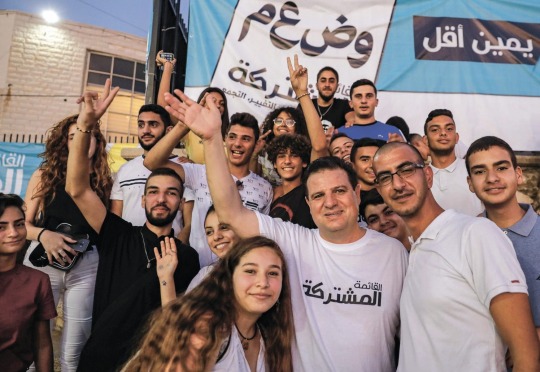
Ayman Odeh poses with supporters during a campaign rally for the Joint List in the Arab town of Kafr Yasif in northern Israel, August 23, 2019.
And contradicting the Trump plan’s claim, recent polls show that more members of these communities now self-identify as Arab, or Arab Israeli, rather than Palestinian.
The idea of revoking the citizenship of thousands of Arab citizens is not new, but rather a continuation of Israel’s discriminatory and alienating policies, and of right-wing incitement against the community. Those policies include the Jewish Nation-State Law, which practically and symbolically institutionalized the primacy of Jewish Israelis and the Hebrew language. Since 1948, we, the Arab minority, have been targeted by unfair laws, budgeting and planning, land confiscations, surveillance and political suppression.
Benjamin Netanyahu and his associates have a long history of inciting mistrust against Arab citizens and their representatives. The prime minister has frequently and groundlessly labelled Arab Knesset members as terrorists and collaborators to galvanize his right-wing base.
And this isn’t the first time that Israel’s right-wing has mooted the idea of a land and population swap. In 2014, serving as foreign minister, Avigdor Lieberman, the head of Yisrael Beitenu Party, promoted a plan to transfer various Israeli Arab towns to the jurisdiction of a future Palestinian state, a riff on a theme he'd already been pushing for a decade. In 2017, Netanyahu repeated that proposal in front of Trump’s senior advisor Jared Kushner and Mideast envoy Jason Greenblatt- two key architects of the Trump peace plan.
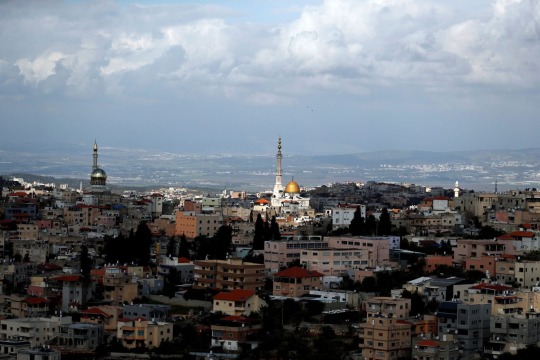
The Arab-Israeli city of Umm al-Fahm in the foreground and Wadi Ara in the background, Israel January 30, 2020.
As Israel prepares for a third round of national elections, incitement against the Arab community in Israel is spiking again. Both the Likud’s Netanyahu and former military chief and Kachol Lavan head Benny Gantz have serially failed to secure the 61-seat threshold needed for a governing coalition.
Simultaneously, Arab voters and their representatives have been thrust into the center of the national political debate, with the electoral strength of the Joint List (an alliance of four parties: Hadash, Taal, Balad, and the United Arab List) as a potential kingmaker and third major party – predicted to win 13-14 seats in the 120 seat Knesset.
Cue the pushback and the incitement. At an "emergency rally" held by the Likud in November 2019, Netanyahu declared that a Gantz minority government formed with the help of the Joint List "is an existential threat to the State of Israel…they will celebrate in Tehran, Ramallah and Gaza the way they celebrate after every terror attack. This would be a historic national terror attack on the State of Israel." By portraying Arabs as traitors and supporters of terrorism, Netanyahu delegitimizes any political alliance in which the Joint List has a voice.
He continued in the same vein: "To be dependent on them all the time, especially at the current time, is an enormous danger to Israel and a breach of a kind never seen before in the history of the country."
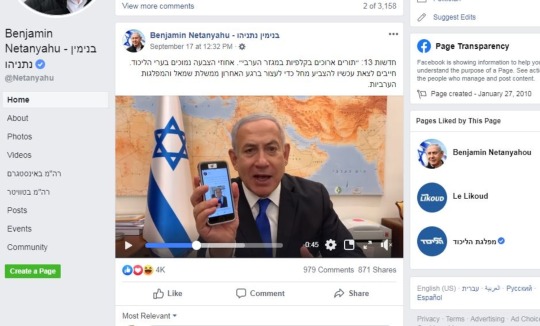
A Netanyahu 'emergency appeal' on Facebook on election day, Sept 17 2019: 'Long queues at Arab polling stations…You must go vote Likud to stop a last-minute leftist-Arab government'Facebook
Arabs in Israel and their leadership have expressed their hostility to the peace plan and all its provisions. They reacted to the idea of being "transferred" out of Israel with anger, doubt and sarcasm. Some labeled it as racist and dangerous – and a transparently expedient attempt to help shore up Netanyahu’s flailing political fortunes.
Dr. Samir Sobhi, mayor of Umm al-Fahm, one of the towns referenced in the Trump plan, responded to the "deal of the century" by affirming the wall-to-wall Palestinian consensus to reject the deal, and further noted that Arabs in Israel refuse to become an "electoral card" in the hands of clandestine deal-making by Netanyahu and Trump. Leaders of the Arab community are actively devising a plan to combat the Triangle transfer proposal.
Arab citizens in Israel and their leaders also have had to contend with hostile questioning about why they oppose the idea of transfer swap if they identify with the Palestinian cause. That, again, is a tendentious reading of our identities. And the repercussions of any such plan go far beyond the issues of identity and ideology, to the very fabric of our lives, and our human rights.
Would we need permits to access the beaches of Haifa and the Dead Sea, places we grew up visiting? How would we maintain our close connections to family members living further within Israel’s 1967 borders? Many of us study and work in cities such as Tel Aviv. What will happen to our jobs and education? The plan foresees a Palestinian state still subject to various forms of Israeli control. So would Israel enforce military rule in our now-Palestinian cities, like it did over Arab villages within Israel from 1948-1966?

Arab Israelis protest Trump’s Mideast peace deal in the Arab-Israeli town of Baqa al-Gharbiya, northern Israel. February 1, 2020.
I suspect that any forced implementation of this plan would be experienced as another Nakba, a radical disconnection from our access and connection to our land once again.
Trump's Mideast plan is profoundly unAmerican, and against American traditions of democracy and individual rights: it would require accepting Israel’s revocation of the citizenship of thousands of its citizens without consulting them, and the targeting of a group of people for their ethnic and religious identity.
And it would risk violating those international laws concerned with the revocation of citizenship. Article 15(2) of the Universal Declaration of Human Rights rules that "No one shall be arbitrarily deprived of his nationality nor denied the right to change his nationality."
Trump’s peace plan threatens the status of Israel’s Arab population, and fuels right-wing detractors whose delegitimization of equality now has the imprimatur of the president of the United States. But it also opens up a bigger set of queries: Who is worthy of full citizenship and protection under the law?
Both the United States and Israel claim democracy to be an identifying trait and distinguishing set of values. But by marketing a plan that attempts to strip people from their citizenship, it seems that those governing the two countries are comfortable with limiting the basic rights of citizens, granting them only to a select group of people along ethnic and religious lines.This doesn’t sound like democracy to me.
Dr. Anwar Mhajne, a native of Umm Al Fahm, is Assistant Professor in the Department of Political Science at Stonehill College, MA. Twitter: @mhajneam
0 notes
Photo

Benjamin „Benny“ Gantz ist ein israelischer Generalleutnant (Raw-Aluf) und Politiker (Chosen LeJisra’el). Er war von 2011 bis 2015 der 20. Generalstabschef (Ramatkal) der israelischen Verteidigungsstreitkräfte (Tzahal) und zuvor von 2005 bis 2007 Oberbefehlshaber des Israelischen Heeres.
Am 27. Dezember 2018 gründete Gantz eine neue politische Partei namens Chosen LeJisra’el (übersetzt: Widerstandskraft für Israel) und trat bei der Parlamentswahl am 9. April 2019 mit dem Ziel, Benjamin Netanjahu als Ministerpräsident abzulösen, an. Gantz' Partei schloss sich mit der von Mosche Ja'alon gegründeten Telem-Partei und der liberalen Jesch Atid von Jair Lapid zum Wahlbündnis Kachol Lavan („Blauweiß“) zusammen. Das Bündnis belegte in Umfragen zwischenzeitlich den ersten Platz, unterlag letztendlich aber gegen den nationalkonservativen Likud von Premier Netanjahu.
Seit dem 30. April 2019 ist Gantz Mitglied der (21.) Knesset und auch Oppositionsführer.
0 notes
Text
Hebrew Basics #4: Verbs, pt. 2 - הִפְעִיל & הֻפְעַל
In lesson 3 you learned basic verb morphology, as well as the two common verb stems פָּעַל and נִפְעַל.
This time we’re going to look at another pair of verb stems - הִפְעִיל and הֻפְעַל.
As you remember from last lesson, each verb stem has a unique meaning it contributes to each verb. These two stems are no exception.
הִפְעִיל carries a causative meaning - a הִפְעִיל verb usually carries the connotation of a subject causing an object to be or act a certain way. For example:
אָכַל akhal ‘to eat’ - הֶאֱכִיל he’ekhil ‘to feed (to cause to eat)’
גָּדַל gadal ‘to grow, to be big’ - הִגְדִּיל higdil ‘to enlarge (to cause to be big)’
כָּתַב katav ‘to write’ - הִכְתִּיב hikhtiv ‘to dictate (to cause to write)’
Note that not all verbs can be converted into a causative form with this stem. While you can make someone eat using one word הֶאֱכִיל, you cant make someone save something by using the verb *הִשְׁמִיר - it just doesn’t exist in the language. For this there is a different auxiliary verb you’ll learn more about in upcoming lessons.
As well as constructing causative verbs, הפעיל also conveys the meaning of change , often expressed in English with the verb ‘to become.’ This is most commonly used with colors:
אָדֹם ‘adom ‘red’ - הֶאֱדִים he’edim ‘to become red, to redden’
צָהֹב tsahov ‘yellow’ - הִצְהִיב hitshiv to become yellow’
כָחֹל kachol ‘blue’ - הִכְחִיל hikhchil1 / hikchil ‘to become blue’
שָׁחֹר shachor ‘black’ - הִשְׁחִיר2 hishchir ‘to become black, to blacken’
אָפֹר ‘afor ‘gray’ - הֶאֱפִיר he’efir ‘to become gray’
לָבָן lavan ‘white’ - הִלְבִּין2 hilbin ‘to become white, to whiten’
Please note that this cannot be done with all colors: כָּתֹם katom ‘orange’, סָגֹל sagol ‘purple’ and וָרֹד varod ‘pink’ do not have a corresponding הפעיל form, while the form for יָרֹק yarok ‘green,’ הוֹרִיק horik, is especially rare.
But can also be used with other adjectives and words:
חָשׁוּךְ chashukh ‘dark’ - הִחְשִׁיךְ2 hichshikh ‘to become dark, to darken’
בָּהִיר bahir ‘light, bright’ - הִבְהִיר2 hivhir ‘to become light/bright, to lighten/brighten’
זָקֵן zaqen ‘old’ - הִזְקִין hizqin ‘to grow old’
סֹמֶק someq ‘blush (n.)’ - הִסְמִיק hismiq ‘to blush’
1. The pronunciation hikhchil uses a double kh consonant, which is pretty hard to pronounce. Therefore it is more commonly pronounced hikchil. This is common with most words whose roots contain a כ-ח cluster.
2. Verbs marked with a 2 also carry the causative meaning ‘to cause to be black/white/dark/bright.’
הֻפְעַל is the passive counterpart to הִפְעִיל, and unlike נִפְעַל which you learned about last lesson, this is its only role. Yay! some simplicity, finally.
הֶאֱכִיל he’ekhil ‘to feed’ - הָאֳכַל ho’okhal / hu’akhal* ‘to be fed’
הִגְדִּיל higdil ‘to enlarge’ - הֻגְדַל hudgal ‘to be enlarged’
הִכְתִּיב hikhtiv ‘to dictate’ - הֻכְתַּב hukhtav ‘to be dictated’
הִשְׁחִיר hishchir ‘o blacken’ - הֻשְׁחַר hushchar ‘to be blackened’
הִלְבִּין hilbin ‘to whiten’ - הֻלְבַּן hulban ‘to be whitened’
* ho’okhal is the prescribed pronunciation, but is pretty uncommon - hu’akhal i far more common in everyday, as well as in formal speech.
Keep in mind that the passive mood is fairly uncommon in speech, as with most languages these days. It is more natural to express a given situation using an active verb than a passive verb.
You might have noticed הֶאֱכִיל ‘to feed’ and הָאֳכַל ‘to be fed’ have a weird pronunciation. The reason for this is that א is a guttural letter. Originally the verbs should be pronounced *הִאְכִיל hi’khil and *הֻאְכַל *hu’khal, but this is difficult to pronounce. You should be familiar with this phenomenon from last lesson. It happens with other verb stems too, but is especially prevalent in הִפְעִיל and הֻפְעַל because of their prefixes. In general it goes as follows:
םִאְ־ / םִעְ־ / םִהְ־ -i’- / -i’- / -ih- > םֶאֱ־ / םֶעֱ־ / םֶהְ־ -e’e- / -e’e- / -ehe-
םַאְ־ / םַעְ־ / םַהְ־ -a’- / -a’- / -ah- > םַאֲ־ / םַעֲ־ / םַהֲ־ -a’a- / -a’a- / -aha-
םֻאְ־ / םֻעְ־ / םֻהְ־ -u’- / -u’- / -uh- > םָאֳ־ / םָעֳ־ / םָהֳ־ -o’o- / -o’o- / -oho-
The last row is usually pronounced םֻאֲ־ / םֻעֲ־ / םֻהֲ־ -u’a- /-u’a- / -uha- in speech.
The first row corresponds to the הִפְעִיל past prefix and the נִפְעַל past and present prefixes (נִ־; הִ־), the second to הִפְעִיל present and future prefixes
(נַ־, תַּ־, יַ־ ,אַ־; מַ־) and the last to all הֻפְעַל prefixes (הֻ־, נֻ־ ,תֻּ־, יֻ־, אֻ־, מֻ־).
As far as I know, this only happens to א, ה, ע. The other gutturals, ר, ח, take a shva like any other letter and verb prefixes preceding them stay the same.
Furthermore, situations where it would be very plausible to use passive verbs in English might not be the same in Hebrew. For instance, if you work at a petting zoo and your supervisor asks whether or not the goats were fed, in English you could say “The goats were fed an hour ago.” However, this isn’t quite the case for Hebrew. Instead of saying:
הָעִזִּים הָאֳכְלוּ לִפְנֵי שָׁעָה. - The goats were fed an hour ago.
It would more commonly be said as:
הֶאֱכִילוּ אֵת הָעִזִּים לִפְנֵי שָׁעָה. - (They) Fed the goats an hour ago.
Although the subject of the sentence (they) can be deduced solely through the conjugation of the verb, it is effectively omitted. Thus it is made irrelevant to the sentence. This is the same effect using a passive verb would convey, since it does not require stating the subject either. Using the 3rd person plural conjugation of the verb doesn’t necessarily mean some group of men did the action: it could be women, a single person, or even a non-human subject. In effect, they acts as a dummy subject, only there to fill in the blank because the language doesn’t allow a sentence without a subject.
The vague they is a very common construction in Hebrew, used when the subject is irrelevant to the sentence and the speaker wishes to emphasize the action itself, rather than the subject.
Conjugations
Now it’s time for your favorite part - conjugating!
The principles of verb conjugation are the same regardless of verb stem. However, each stem as some weird phenomena that require me to teach each one separately.
Past Tense
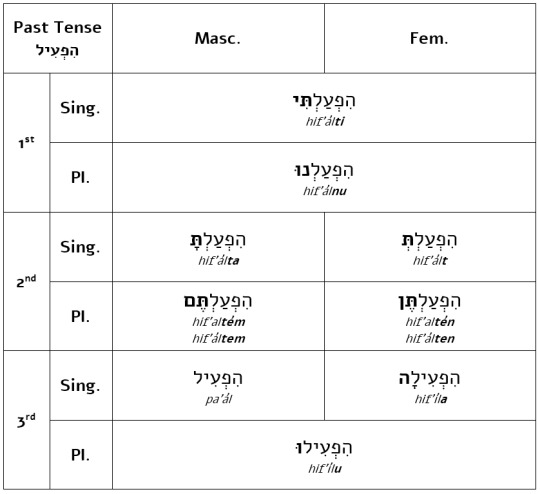
The first four rows are irregular to the conjugation, but you will see similar phenomena in the future. The stressed /i/ changes into an /a/ in some conjugations: הֶאֱכִיל > הֶאֱכַלְתֶּי he’ekhil > he’ekhalti, הֶאֱדִים > הֶאֱדַמֱתֶּם he’edim > he’edamtem. I did some research and apparently this change has no clear explanation, so take it as it is.
Future Tense
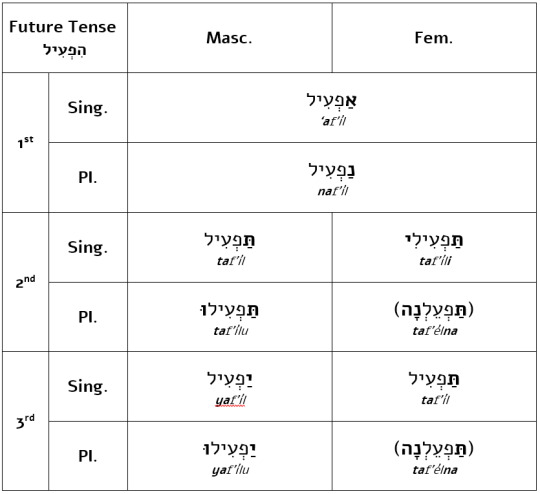

The forms marked with an asterisk are irregular and you should no why from last lesson. Here’s a reminder: Stress moves to suffix, 2nd radical letter gets reduced to a shva and since פ־ע־ל has a guttural ע it can’t take the shva, so it morphs to a /a/, marked as םֲ. Again, the right hand pronunciation is the general case, the left hand is the specific pronunciation for roots who have a guttural 2nd radical letter.
Yay! That’s it for this time.
I don’t think practice is really necessary here, so I won’t include any this time. Probably will next lesson.
See you next lesson!
#hebrew#hebrew lesson#hebrew lessons#hebrew language#learn hebrew#study hebrew#עברית#שיעור עברית#לומדים עברית#Ivrit#שפה עברית#lessons#verbs#basics
42 notes
·
View notes
Text
Week of: March 25th
9-11 Class Learning Highlights
Language Arts
Students presented on their nonfiction research topics this week! Presentations were supported with organized notes and visual components, such as posters, google slides, and demonstrations. Students were assessed based on nonverbal skills (eye contact and posture), vocal skills (elocution and enthusiasm), and knowledge of content.
Math
Shelby 4th grade: Students continued their investigation of fractions and decomposed them as a sum of unit fractions using tape diagrams and decomposed non-unit fractions and represented them as a whole number times a unit fraction using tape diagrams. Students also decomposed fractions into sums of smaller unit fractions using tape diagrams and using area models to show equivalence.
Jen 4th grade: This week students were assessed on the first section of the fractions unit and we reviewed terms and skills as a group as needed. Students also learned how to find equivalent fractions using an area model and multiplication.
5th grade: This week, students continued their work with partial quotients and multi-digit whole number division and began dividing decimals. Students divided three- and four-digit dividends by two-digit divisors resulting in two- and three-digit quotients and reasoned about the decomposition of successive remainders in each place value. Students also divided decimal dividends by multiples of 10, reasoned about the placement of the decimal point, and made connections to a written method.
Science
Our mission continues! This week we traveled back another 50 million years as we tracked how our animals have evolved through time. Additionally, we began a new project growing kidney beans in the classroom to help us understand how organisms grow and give us a visual of the tree of life. Both the the Kachol and Lavan classes will have a plant to monitor, track, and keep alive. Let’s see which group has a greener thumb!
History
4th grade: Students completed their Native American research projects! Students had the chance to show and present their projects to a classmate during Work Time and received feedback and help with the editing process. We will be doing a gallery walk next week, where students will get a chance to view all of the projects and learn some new information.
5th grade: We learned about how the Constitutional Convention sought to fix the weak government that was created by the Articles of Confederation. Students learned about the Virginia Plan and the New Jersey Plan and about the rights of larger states versus smaller states.
Hebrew
Dorit’s groups: This week we continue to sharpen our pronunciation, comprehension and use of the new vocabulary in writing and speaking. Some students are preparing various projects of their choice: sports, Israeli songs, and short Hebrew stories.
Daphna’s group: We continued our learning about the kinneret and created a trivia game with our knowledge. We practiced typing in Hebrew and got familiar with the Hebrew keyboard.
Chumash
Rashi and Ramban: We learned about Ya’akov’s deal with Lavan and spoke about his love of Rachel. We tried to understand his reasoning for staying with Lavan even after he tricked him, and working for 7 more years after he got Rachel.
Eben Ezra: We finished parashat Miketz and started working on our assessment! Students brought commentary, pesukim and their personal opinions to explain motivations, thoughts, and feelings of the characters in this cliff hanger point of the story.
Kindness: We continued learning the text of Yaakov leaving his father-in-law Lavan’s household and preparing to return home to his parents. While we look at this text we are also beginning to prepare for Pesach, especially the part of the Seder where Lavan is mentioned. This was followed by a comparison of Lavan and Paroah, specifically how they both played a part in shaping the creation of the nation of Israel.
The Dreamers: Yosef finally reveals who he really is to the brothers. After many trials and tribulations, we see how both Yosef and his brothers have changed since the beginning of the story, re-framing many of the same issues we discussed at the beginning. Furthermore, we began to hear about family dynamics on Pesach by learning the text of the Four Children in the Haggadah.
Mishnah
4th grade: Students completed their learning in the first mishnah of Mishnah Brachot, focusing on zmanim, or times for prayer at night, and then began learning the second mishnah, which discusses zmanim for the morning Shemah.
5th grade: We completed our learning in the 4th perek of Mishnah Brachot and began learning the 5th perek! This perek introduces some new terms and concepts, such as praying with koved rosh, a serious state of mind.
Community Time
In preparation for our Luria Haggadah companion, the 9-11 students prepared questions for their seder tables guests to make sure that everyone gets what they need, a piece from our “I Will Be Kind” commitment.
Questions
Language Arts
Reflecting on your presentation and the rubric, what are you most proud of? What is one speaking skill that you will work on for your next presentation?
Math
Shelby 4th grade: How do number bonds connect to an addition sentence for fractions? What does it mean when a fraction is greater than one? When we draw tape diagrams, why do we need to label 1? What would happen if we did not label 1? How is multiplying fractions like multiplying whole numbers?
Jen 4th grade: What is a UNIT fraction? What is the rule for finding equivalent fractions? (Hint: what TWO numbers must you multiply?)
5th grade: A baker was going to arrange 432 desserts into rows of 28. The baker divides 432 by 28 and gets a quotient of 15 with remainder 12. Explain what the quotient and remainder represent.
A candy company packages caramel into containers that hold 32 fluid ounces. In the last batch, 1,848 fluid ounces of caramel were made. How many containers were needed for this batch? 2.1 liters of coffee were equally distributed to 30 cups. How many milliliters of coffee were in each cup?
Science
How does seeing the growth of a real plant help us understand the different branches in the family tree of life?
History
4th grade: What is one completely new and exciting piece of information that your classmates will be learning from your project?
5th grade: What were the Virginia Plan and the New Jersey Plan? Which one supported smaller states and which one supported bigger states?
Hebrew
Dorit’s groups: What are some of the new Hebrew words you learned this week?
Daphna’s group: מה אתם יודעים על הכנרת?
Chumash
Rashi and Ramban: What is Ya’akov thinking? What is he feeling? Does he have mixed feelings? About what?
Eben Ezra: Which brother are you? What’s going through your head when Binyamin is taken?
Kindness: How did Lavan and Paroah both shape the course of early Jewish history?
The Dreamers: What can we learn from the growth of Yosef and his brothers that can help us in our own family dynamics?
Mishnah
4th grade: What were some of the new concepts which we learned about for Kriat Shemah in the morning?
5th grade: What does praying in koved rosh (a serious state of mind) mean to you?
0 notes
Text
The only outcome I can think of that doesn’t involve Lieberman is if Bibi takes Gantz’s offer to do a power sharing agreement, so Likud will control the post of PM for half of the term and Kachol Lavan will control the other half. It’s going to piss off the religious vote and any liberals who were dumb enough to believe in Gantz as somehow constituting a change, but maybe it’ll be more palatable to the Israeli electorate than having 3 back to back elections
6 notes
·
View notes
Text
Anywhomst, before anyone gets too excited about Netanyahu maybe being pushed out of power, friendly reminder that a Likud-free coalition would still entirely depend on Lieberman and that Gantz's reaction to Netanyahu's annexation plan was to say that actually this was the Kachol Lavan plan and that Netanyahu is a bigmouth with no means of actually making it happen (unlike military hero and smartest, toughest, sexist man in Israel Benny Gantz)
4 notes
·
View notes
Link
Khaliji hasbara trolls are amazing
“Dear Israelis, if Kachol Lavan wins there will be a big mess in the country, you will have to flee from Israel, Saudi Arabia will accept you. You must only choose Netanyahu, a strong leader.”
4 notes
·
View notes
Text
The year is 2021. Kachol Lavan has been in power for two years. Benny Gantz has revealed that he was the secret leader of both PFLP and Hamas for years now. The leftist government under Gantz and Lieberman has given citizenship to Palestinian residents of the West Bank and Gaza and made it legal to hunt Jews for sports. Likud and its supporters have been thrown into the sea. The Wailing Wall has been demolished to make room for Kaaba 2. Hezbollah is now Israel's top ally in the region and all of Israel's nuclear weapons have been pointed at the US. Israel is in the process of forming a federation with the Islamic Republic of Iran.
This is not a shitpost, this is what will happen if you don't vote for Likud today.
3 notes
·
View notes
Note
tbf to joint, supplying confidence to govts without formally being part of them in exchange for the govt supporting certain policies is a proven tactic under parliamentary systems - just look at the way that the dup has been holding the uk govt by the balls wrt to northern ireland since the 2017 uk election for a recent example. this could potentially work for joint too
Right, and that would make sense if the government were composed of left-leaning parties, but tbf Kachol Lavan is composed of ex-Likudniks who are tired of Bibi for personal reasons/reasons of propriety and the Lapid cult of personality, I don't see how that in conjunction with the ghouls of Likud (minus Bibi) and maybe Yisrael Beitanu, which is the only possible configuration for a governing coalition that doesn't include Joint, could be expected to actually deliver on any of Joint's demands, which just makes me strongly suspicious that their goal here isn't to form a government but rather to force new elections.
1 note
·
View note
Text
Looks like Joint will most likely be endorsing Gantz to form the coalition:
They said their demands in talks with Gantz’s party concern issues such as fighting violence in the Arab community, legalizing unrecognized Bedouin villages, rebuking or amending the so-called Nation-State Law, and renewing talks with the Palestinian Authority on a solution to the Israeli-Palestinian conflict. The Joint List would also ask to freeze house demolitions in Arab communities and annul the "Kaminitz Law,“ which is intended to crack down on illegal construction, but critics say unfairly targets Israeli Arabs.
"We have to come to our voters with something,” one of the sources said. “Kahol Lavan also has to deal with those sorts of questions, and we’ll decide based on what we hear from them.” (X)
However, they will not become part of the ruling government. I have no idea how they expect Gantz to either form a coalition without their participation, or to be able to adhere to their demands if the Kachol-Lavan+Likud+Yisrael Beitanu unity government becomes a thing. Maybe Odeh is playing a game of 5th dimensional chess and wants another election to take place in the hopes of saying to the Israeli public that Gantz and Lapid are incapable of forming a non-Netanyahu government and getting someone else to try to be the top dog?
1 note
·
View note
Note
Why would a unity govt between kachol lavan and likud even need binyamin israel? Wouldn’t they have enough votes without binyamin?
I'm gonna assume that you mean Yisrael Beitanu. It really doesn't, Lieberman just wants to be back in the governing coalition
0 notes